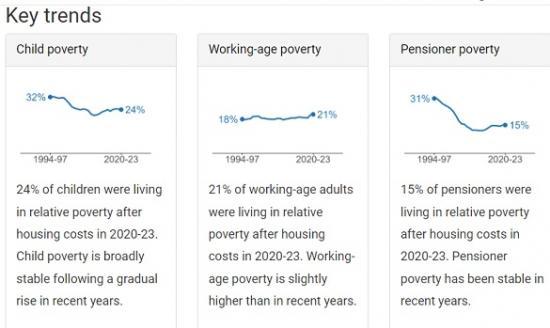Poverty And Income Inequality In Scotland 2020-23
26th March 2024

This report presents three-year averaged estimates of the proportion of people, children, working-age adults and pensioners in Scotland living in poverty, and other statistics on household income and income inequality. These estimates are used to monitor progress in reducing poverty, child poverty and income inequality.
Similar to the previous two annual publications, the latest estimates are only for a two year period. The latest estimates are for between April 2021 and March 2023 as data for April 2020 - March 2021 was removed due to quality issues related to the pandemic.
Longer-term trends of poverty and income inequality in the UK, which are similar to those in Scotland, are available from the Department for Work and Pensions' Households Below Average Income publication.
What you need to know
Statistics in this report are based on data from the Family Resources Survey. This survey has been the main source of information on household income and poverty in Scotland since 1994/95.
Poverty measures
The Scottish Government measures different aspects of poverty with different indicators. The most commonly used poverty indicator in Scotland for showing trends is relative poverty after housing costs. Other poverty measures in this report are absolute poverty, material deprivation, and degrees of household food security. These are included in additional charts throughout the report.
Unless otherwise stated, these statistics are based on net income and adjusted for household size. Net income is income from earnings, social security payments and other sources minus taxes. All incomes are in 2022/23 prices, so the purchasing power is comparable over time. Estimates in this publication are rounded to the nearest £1 for weekly incomes, £100 for annual incomes, 1% for proportions and ratios, and 10,000 for populations. Poverty is defined at the household level. If the household income is below the poverty threshold, all people within the household are in poverty.
Survey data
The estimates in this publication are based on a sample survey and are therefore subject to sampling variation.
For example, the child poverty rates for Scotland in the latest period can vary within a typical uncertainty range of plus or minus six percentage points, or plus or minus 70,000 children. This means that the proportion of children in relative poverty is likely to be somewhere between 18% and 30%. And the number of children in relative poverty after housing costs is likely to be somewhere between 170,000 and 310,000 children. Poverty rates and numbers shown in this report give the central estimates only.
Read the full detailed report HERE
Read Fraser of Allender commentary on this report
